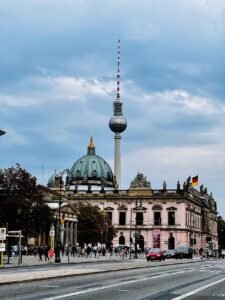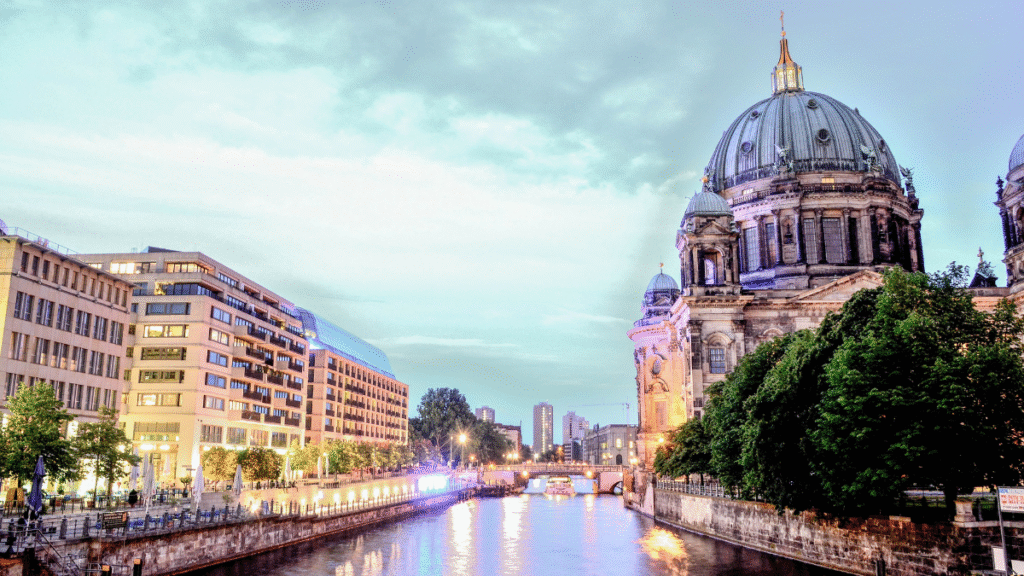Berlin is more than the capital of Germany: it is a palimpsest of different historic layers, it is artist playground, it is a city of survival and regeneration. A city with its turbulent history, vivacious culture and an eclectic collection of old and new buildings, Berlin is a place that greets visitors with a city that is part museum, part contemporary metropolis.
Are you obsessed with Cold War history, fascinated by the most significant museums in the world, or attracted to street art and underground club? Do you want to find pleasure in German cuisine and green parks? Berlin has something to offer to everyone, little by little. Berlin is home to a rich variety of ways to spend your time and money, and this guide to the city will find them all, helping you experience the best of Berlin—the personifications presented in the book, when to visit, how to navigate the city, which hotels to stay at, which types of food to drink, where to go and spend time, and which places better to avoid.

Why Visit Berlin?
1. A Living History Book
Berlin has history on its sleeves. Explore remains of the Berlin Wall, sobering memorials such as the Holocaust Memorial and go inside Cold War watchtowers. This city does not deny its past—it glares directly and openly in the face of its past.
2. A Civilization Giant
Berlin has more than 170 museums, innumerable galleries, and such illustrious establishments as Museum Island (a UNESCO World Heritage Site). Berlin has had a rich cultural life that spans all the way back to classical art and takes them through the contemporary installations.
3. Wide Variety of Neighborhoods with Different Vibes
Every neighbourhood of Berlin has its spirit: Kreuzberg is hip and artistic, Mitte is historical and central, Prenzlauer Berg is trendy and with families, and Friedrichshain is thriving with nightlife.
4. Famous Nightlife Around the World
The clubbing experience is epic. Famous clubs such as Berghain are known worldwide, but even the small clubs and bars guarantee unreal nights and sun-filled mornings.
5. Food Scene to All Tastes
Berlin has it all: traditional German cuisine, Turkish street food, and Michelin-starred restaurants—whatever the capital city excels at, it shows in its food and love of innovation.
When to Visit Berlin
Spring (March–May):
Spring is the perfect season with mild weather and flowering parks. The mass tourist flows are weakened, and outdoor activities begin to gain momentum.
Summer (June–August):
Summer is the time when life is alive in Berlin. The parks are jammed, open-air cinemas are going into the wee small hours, and beer gardens are humming. It is also tourist season.
Autumn (September–November):
Cool and colourful, the autumn does not provide many crowds and clean air but a riot of colour. Museums and galleries will be more attractive with the decrease in temperatures.
Winter (December–February):
It has a magical yet cold winter filled with Christmas markets, delicious dishes, and twinkling lights in Berlin. The days may be short, but the experience is full-bodied, particularly when you are a fan of snow-covered urban places.
How to Go to Berlin
By Air:
The international hub of the city is Berlin Brandenburg Airport (BER), connecting the city with Europe and the rest of the world. It will take approximately 30 (S-Bahn) to 40 (Airport Express) minutes to get to the city centre using the train.
By Train:
The city of Berlin is a well-networked city within the rest of the European cities using high-speed trains such as the ICE train of the Deutsche Bahn. The main rail station is Berlin Hauptbahnhof and a transport miracle on its own.
By Bus or Car:
Low-cost travelers can use buses (the most common one is FlixBus). You can drive, and parking in town is also restricted and costly in central Berlin.

Travelling in Berlin
The public transport system of Berlin is among the best in Europe. It includes:
-
U-Bahn (subway)
-
S-Bahn (commuter rail)
-
Trams
-
Buses
The cheapest option is a Berlin WelcomeCard, or daily/weekly ticket, which has unlimited journeys with an added benefit of discounted tickets at popular attractions. Biking also catches on, and there are numerous bike-renting services and bike lanes.
It is extremely suggested to walk more, particularly in central districts where attractions are situated closely.
Where to Stay in Berlin
Mitte:
It is ideal to be had by first-time visitors. A house of, amongst other things, the Brandenburg Gate, the Museum Island and numerous hotels, shops and restaurants.
Kreuzberg:
Fashionable, diverse and with bars, galleries and cheap cafes. Ideal for younger travelers.
Prenzlauer Berg:
Trendy and housy. Less busy, greener with great cafes, family, and couples friendly.
Friedrichshain:
Colorful nocturnal and alternative atmosphere. Near to East Side Gallery and clubs.
Charlottenburg:
A fancier district with traditional buildings, shopping boulevards, and less noisy streets.
Berlin Attractions You Have to See
-
Brandenburg Gate
You cannot possibly go to Berlin without seeing this neoclassical gate that symbolizes the unification of the city. It is a must-see, especially at night when it is lit up. -
Berlin Wall Memorial and East Side Gallery
Discover the history of the division of the city of Berlin at the preserved Berlin Wall Memorial and be amazed by the colorful paintings at the East Side Gallery, an open-air gallery of 1.3 km. -
Museum Island
These five museums located in this complex comprise things like Egyptian artifacts (Pergamon Museum) and classical art (Alte Nationalgalerie). It takes several days to be occupied by art lovers. -
Reichstag Building
Palace of the German parliament. Reserve its glass dome to see a panoramic view of Berlin as well as a lesson in democratic transparency. -
Holocaust Memorial (Memorial to the Murdered Jews of Europe)
This is an eerie area of concrete flat slabs and the middle of Berlin. Spend some time to stroll and make a visit to the underground information center. -
Berlin Cathedral (Berliner Dom)
Glamorous and beautiful. The dome has high-altitude views of the city. -
Tempelhofer Feld
An old airport converted to an enormous city park. Fly kites, ride bikes, and simply sleep on the runway. -
Charlottenburg Palace
Grandeur of the baroque. Visit rich apartments and palaces in West Berlin. -
Checkpoint Charlie
The best-known border between East and West Berlin. It has a small museum and a photo opportunity, but what is there is mostly recreated. -
Potsdamer Platz & Sony Center
One of the markers of the modern rebirth of Berlin. Shiny buildings, movie theatres, food, and the past are clashing here.
The Finest Green Spaces in Berlin
-
Tiergarten: Central park analog of Berlin. Perfect for picnics, walks, or a nap under a tree.
-
Mauerpark: The locality is well-known due to its flea market (every Sunday) and karaoke (open-air).
-
Treptower Park: Space houses a huge Soviet War Memorial and pleasant walks along the banks of the river.
-
Volkspark Friedrichshain: This multifusion park close to the river is a local favorite and has wood tracks, lakes and open-air movies during summer.
What to Eat and Drink in Berlin
German Classics:
-
Currywurst: A sausage, cut in thins, sprinkled with spiced ketchup and curry. A specialty of Berlin.
-
Schnitzel: A cutlet of meat breaded and served with potatoes or salad.
-
Berliner (Pfannkuchen): A doughnut that is filled with jelly that is found at the bakeries.
-
Pretzels and Bratwurst: Sold in markets and beer gardens.
International Eats:
Döner kebabs have become a local favorite in Berlin due to the Turkish population in the city. It also has fantastic Vietnamese-style, Middle Eastern and vegan food throughout the city.
Desserts & Coffee:
Have a taste of apple strudel or a piece of cheesecake with a cappuccino in a third-wave coffee shop within Prenzlauer Berg or Kreuzberg.
Local Drinks:
-
Berliner Weisse: A sour beer usually mixed with raspberry syrup or woodruff syrup.
-
German Pilsner and craft beers are widely available.
-
Club Mate: A caffeinated beverage that techies and night owls love.
Famous Nightlife in Berlin
Clubs:
-
Berghain: The myth and the legend. Known for its stringent door policies and marathon electronic sets.
-
Sisyphos: Nature, arts and music by the river.
-
KitKatClub: A famous club known for its outrageous dress codes.
Bars:
Recommended rooftop bars include Klunkerkranich and pleasant speakeasies in Neukölln and Mitte.
Live Music:
Whether it is punk rock, jazz or classical performances held at the Berlin Philharmonie, you are guaranteed something playing out every night.

Berlin Day Trips
-
Potsdam:
See Sanssouci Palace, aka the Prussian Versailles, and wander through charming streets and gardens. -
Sachsenhausen Concentration Camp:
An informative and eye-opening experience that is only 45 minutes outside of Berlin. It is advisable to go there on guided tours. -
Spreewald:
A quiet patch of canals, with perfect conditions to kayak and try local pickles and horseradish treats. -
Wannsee:
A summer resort that offers swimming, sunbathing and biking around the lakes.
Example 5-Day Itinerary
Day 1:
Visit Mitte: Brandenburg Gate, Reichstag Dome, Holocaust Memorial, Museum Island.
Day 2:
Go to the Berlin Wall Memorial, the East Side Gallery and Checkpoint Charlie. Watch the sunset at Tempelhofer Feld.
Day 3:
Visit Charlottenburg Palace, relax in Tiergarten, shop at Karl Friedrich Allee, and dine at a German restaurant.
Day 4:
Take a day trip to Potsdam or Sachsenhausen. Return for dinner and drinks in Kreuzberg.
Day 5:
Browse Mauerpark flea market, get brunch in Prenzlauer Berg, and end with a view from the Berlin TV Tower.
Travel Tips
-
Language: German is the official language; however, English is widely used in tourist destinations.
-
Currency: Euro. Cards are accepted in most places, although it’s better to carry a bit of cash.
-
Tipping: Between 5–10 percent is standard when service is not included.
-
Safety: Berlin is fairly safe. Just remain alert in congested areas, particularly tourist hotspots.
-
Wi-Fi: Free access is available in cafes, museums, and many public spaces.
Final Thoughts
Berlin is a city that does not only invite you to be a visitor, but also a learner. It is not polished and perfect, but that is the beauty of it. It is a place where narratives count—stories that are told in peeling buildings, street murals, every meal, and the pulse of electronic music.
Bring yourself in as a curious person. Remain in the creativeness. Don’t leave only with photos, but with perspective.
Berlin is not just a European tourist destination. It is a city that gets inside of you.
Save pin for later.


